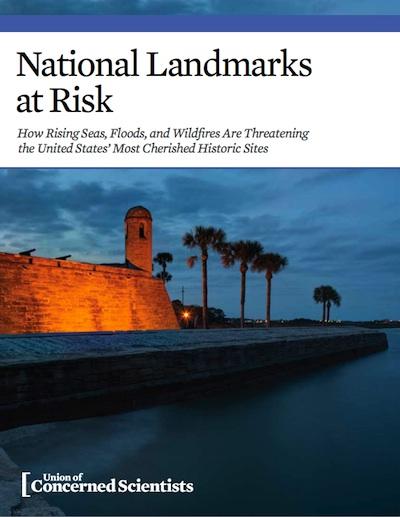Treasures of history, culture, and natural beauty contained within the National Park System are increasingly at risk to the perils of climate change, with flooding and wildfire likely to sweep numerous park sites across the country, according to the Union of Concerned Scientists.
Coastal parks such as Everglades National Park in Florida, the Boston Historic District in Massachusetts, and the Bering Land Bridge National Preserve in Alaska stand to be inundated by rising oceans, while Mesa Verde National Park in Colorado and Bandelier National Monument in New Mexico are at risk of wildfires spurred by the warming, and drying, climate in the Southwest.
The scenarios laid out in National Landmarks at Risk, How Rising Seas, Floods, and Wildfires Are Threatening the United States' Most Cherished Historic Sites are not theoretical predictions, but rather case studies of landmarks that must be protected against the impacts of climate change, the authors write.
Now, nearly 100 years since the founding of the NPS, the agency finds itself forced to develop new ways to protect the natural and cultural resources in its care from the impacts of a changing climate. A recent NPS analysis shows that 96 percent of its land is in areas of observed global warming over the past century and that at least 85 sites have already recorded changes attributable to climate change. Many more have seen consequences such as increases in winter temperature, decreased snowpack, and shifts in precipitation that are consistent with climate change. Another study by NPS scientists has determined that more than 100 national parks are vulnerable to the combined impacts of sea level rise and storm surges.
With that evidence in hand, the Union of Concerned Scientists says it's urgent that the country begin work "to prepare our threatened landmarks to face worsening climate impacts; climate resilience must become a national priority and we must allocate the necessary resources. We must also work to minimize the risks by reducing the carbon emissions that cause climate change. The science is clear that by abating our carbon pollution we can slow the pace of change and thereby lower the risks posed by extreme heat, flooding, and rising seas."




Comments
You are only pointing to trends that support your ability to deny. Meanwhile, there are other trends that are showing that we are in a major warming period of the Earth. Here is current news too that shows another trend.
http://www.climate.gov/news-features/event-tracker/california-facing-wor...
Here is another good tool for you to try and find trends to help substantiate your "denial agenda". Pull up all the data you want to try and substantiate your claims. http://cci-reanalyzer.org/DailySummary/
Gary - my links pointed out you were wrong. Hurricanes and tornados are not "increasingly more frequent."
Again - few (and not me) are denying that climate changes. The question is whether man is causing it. The scientific method says you create a theory and then test it. The theories of what was supposed to happen under the AGW models have proven to be wrong.
While that may have been true in the Atlantic last year, that was not the case in the Pacific and especially in Asia, which experienced some super storms that were very cataclysmic to parts of that region.
Also, like I said, it's hard to take a realtor very seriously who doesn't spend days in the field.
http://www.livescience.com/38017-hurricanes-more-frequent-and-stronger.html
And even simpler, when man alters a forest by cutting it down and turning into pavement for shopping centers and subdivisions it changes the microclimate of that area, which has an accumulative effect on the overall climate. Either way, carry on. Nothing I say will change your opinion.Your claim was based on your experience in the Smokies. Let me know when the Smokies move to Asia.
Hurricane Sandy was at the time the largest hurricane ever documented. The width and magnitude was broken last year by Cyclone Haiyan. Hurricane Sandy was gigantic, and it's arms affected places as far away as the Smokies. I was there at the time, and witnessed it.
Continue on. Continue on.
When Sandy hit the Smokies it wasn't even a hurricane. Its these kind of fabrications that show how desperate the AGW folks are.
Alferd Runte, interesting post. Fundamentally, I agree that self reliance is an important attribute, to some extent the helping hand is at the end of the arm. Maybe it just is my age, but there are circumstances that require people to seek assistance, health issues, severe injuries on the job, living wages that enable a person to meet the basic needs of food, shelter, etc. well the list is quite lengthly. I think it is fair to debate the role of the government in all of the above, not to mention education, environment, public infrastructure, the referee and rules in disputes, national defense, food production, consumer protection, etc., but I do not feel the concept of total self reliance in todays society is realistic. The issue of population is one good example. What little knowledge I do have leads me to believe that education and the empowerment of women (and all persons for that matter), is a significant start in the right direction.
Really? Ok, if you want to believe that. The eye never hit the Smokies. Its gigantic arms that stretched for over a thousand miles did.
/2012/10/updated-hurricane-sandy-nears-land-national-park-service-closing-parks-and-offices10742
And here is a video of the satellite sequence of that massive hurricane and its effects on the Eastern US.
https://www.youtube.com/watch?v=zx0vJvB4HTQ